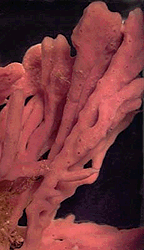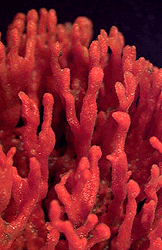Porifera
Sponges
- Calcarea
- Calcinea
- Calcaronea
- Hexactinellida
- Amphidiscophora
- Hexasterophora
- Demospongiae
- Homoscleromorpha
- Tetractinomorpha
- Ceractinomorpha
References
Adams, C.L., J. O. McInerney, and M. Kelly. 1999. Indications of relationships between Poriferan classes using full-length 18S rRNA gene sequences. Memoirs of the Queensland Museum 44:33-43.
Bergquist, P. R. 1978. Sponges. Hutchinson and Company, London.
Bergquist, P. R. 1985. Porifera relationships. Pages 14-28 in The Origins and Relationships of Lower Invertebrates. (S. Conway Morris, J. D. George, R. Gibson, and H. M. Platt, eds.) Clarendon, Oxford.
B?ger, H. 1988. Versuch ?ber das phylogenetische System der Porifera. Meyniana 40:143-154.
Borchiellini, C., C. Chombard, B. Lafay, and N. Boury-Esnault. 2000. Molecular systematics of sponges (Porifera). Hydrobiologia 420:15-27.
Borchiellini, C., C. Chombard, M. Manuel, E. Alivona, J. Vaceleta, and N. Boury-Esnault. 2004. Molecular phylogeny of Demospongiae: implications for classification and scenarios of character evolution. Molecular Phylogenetics and Evolution 32(3):823-837.
Borchiellini C., M. Manuel, E. Alivon, N. Boury-Esnault, J. Vacelet, and Y. Le Parco. 2001. Sponge paraphyly and the origin of Metazoa. Journal of Evolutionary Biology 14(1):171-179.
Botting, J. P. and N. J. Butterfield. 2005. Reconstructing early sponge relationships by using the Burgess Shale fossil Eiffelia globosa, Walcott. Proceedings of the National Academy of Sciences (USA) 102(5):1554-1559.
Brusca, R.C., and G.J. Brusca. 2003. Invertebrates. Second Edition. Sinauer Associates, Sunderland, Massachusetts.
Carrera, M. G. and J. K. Rigby. 1999. Biogeography of Ordovician sponges. Journal of Paleontology 73:26-37.
Cavalier-Smith, T., M. T. E. P. Allsopp, E. E. Chao, N. Boury-Esnault, and J. Vacelet. 1996. Sponge phylogeny, animal monophyly, and the origin of the nervous system: 18S rRNA evidence. Canadian Journal of Zoology 74:2031-2045.
Chombard, C., N. Boury-Esnault, A. Tillier, and J. Vacelet. 1997. Polyphyly of "sclerosponges" (Porifera, Demospongiae) supported by 28S ribosomal sequences. Biological Bulletin 193:359-367.
Chombard, C., N. Boury-Esnault, and A. Tillier. 1998. Reassessment of homology of morphological characters in tetractinellid sponges based on molecular data. Systematic Biology 47:351-366.
De Vos, L., K. Rutzler, N. Boury-Esnault, C. Donadey, and J. Vacelet. 1991. Atlas of Sponge Morphology. Smithsonian Institution Press, Washington, DC.
Erpenbeck, D., G. P. McCormack, J. A. J. Breeuwer and R. W. M. van Soest. 2004. Order level differences in the demosponge LSU structure?New insights in an old taxon. Molecular Phylogenetics and Evolution 32(1):388-395.
Hooper, J. N. A. and R. W. M. van Soest, eds. 2002. Systema Porifera: A Guide to the Classification of Sponges. Kluwer Academic/Plenum, Amsterdam. 1810 pp.
Koziol, C., S. P. Leys, I. M. M?ller, and W. E. G. M?ller. 1997. Cloning of Hsp70 genes from the marine sponges Sycon raphanus (Calcarea) and Rhabdocalyptus dawsoni (Hexactinellida). An approach to solve the phylogeny of sponges . Biological Journal of the Linnean Society 62:581-592.
Kruse, M., S. P. Leys, I. M. M?ller, and W. E. G. M?ller. 1998. Phylogenetic position of the hexactinellida within the phylum porifera based on the amino acid sequence of the protein kinase C from Rhabdocalyptus dawsoni. Journal of Molecular Evolution 46:721-728.
Lafay, B., N. Bouryesnault, J. Vacelet, and R. Christen. 1992. An analysis of partial 28s ribosomal-RNA sequences suggests early radiations of sponges. Biosystems 28:139-151.
Li, C. W., J. Y. Chen, and T. E. Hua. 1998. Precambrian sponges with cellular structures. Science 279:879-882 .
Manuel, M., C. Borchiellini, E. Alivon, Y. Le Parco, J. Vacelet, and N. Boury-Esnault. 2003. Phylogeny and evolution of calcareous sponges: monophyly of calcinea and Calcaronea, high levels of morphological homoplasy, and the primitive nature of axial symmetry. Systematic Biology 52:311-333.
M?ller, W. E. G. 1998. Origin of Metazoa: Sponges as living fossils. Naturwissenschaften 85:11-25.
Nichols, S. A. 2004. An evaluation of support for order-level monophyly and interrelationships within the class Demospongiae using partial data from the large subunit rDNA and cytochrome oxidase subunit. Molecular Phylogenetics and Evolution 34(1):81-96.
Reid, R. E. H. 2003. Demosponge phylogeny. Pages 113-125 in: R. L. Kaesler, ed., Treatise on Invertebrate Paleontology, Part E. (revised): Porifera. The Geological Society of America and The University of Kansas, Boulder and Lawrence.
Reitner, J. and D. Mehl. 1995. Early paleozoic diversification of sponges: new data and evidence. Geol. Pal?ont. Mitt. Innsbruck 20:335-347.
Rigby, J. K. 1987. Phylum Porifera. Pages 116-139 in Fossil Invertebrates. (R. S. Boardman, A. H. Cheetham, and A. J. Rowell, eds.) Blackwell Scientific Publications, Palo Alto, California.
Stearn, C. W. 1980. Classification of the Paleozoic stromatoporoids. Journal of Paleontology 54:881-902.
Steiner, M., D. Mehl, J. Reitner, and B. D. Erdtmann. 1993. Oldest entirely preserved sponges and other fossils from the Lowermost Cambrian and a new facies reconstruction of the Yangtze Platform (China). Berliner Geowissenschaftliche Abhandlungen (E) 9:293-329.
van Soest, R. W. M., T. M. G. van Kempen, and J. C. Braekman, eds. 1994. Sponges in Time and Space. Balkema Press, Rotterdam.
VanSoest, R. W. M. and E. Hajdu. 1997. Marine area relationships from twenty sponge phylogenies. A comparison of methods and coding strategies. Cladistics 13:1-20.
West, L. and D. Powers. 1993. Molecular phylogenetic position of hexactinellid sponges in relation to the Protista and Demospongiae. Mol. Mar. Biol. Biotechnol. 2:71-75.
Wiens, M., L. Lukic, W. E. G. M?ller, and V. Gamulin. 1999. Ubiquitins (polyubiquitin and ubiquitin extension protein) in marine sponges: cDNA sequence and phylogenetic analysis. Biological Journal of the Linnean Society 67:43-56.
Wood, R. 1990. Reef-building sponges. American Scientist 78:224-235.
Woollacott, R. M. and R. L. Pinto. 1995. Flagellar basal apparatus and its utility in phylogenetic analyses of the Porifera. Journal of Morphology 226:247-265.
Information on the Internet
- Porifera Web Page.
- Introduction to Porifera. UCMP Berkeley.
- Phylum Porifera. Animal Diversity Web. University of Michigan Museum of Zoology.
- Sponge Guide. Sponge Classification and Identification. John Hooper, Queensland Museum.
- Research on Sponges. Gert W?rheide, Queensland Museum.
- Sponge Reefs on the Continental Shelf. Geological Survey of Canada.
- The Sponges of British Columbia. Curt Smecher, University of British Columbia.
- Khoyatan Sponge Page. Sponges of The Northeast Pacific. Khoyatan Marine Laboratory.
Title Illustrations
| Scientific Name | Haliclona |
|---|---|
| Creator | David Remsen |
| Copyright | © 1995 Marine Biological Laboratory, Woods Hole |
| Scientific Name | Microciona |
|---|---|
| Creator | David Remsen |
| Copyright | © 1995 Marine Biological Laboratory, Woods Hole |










